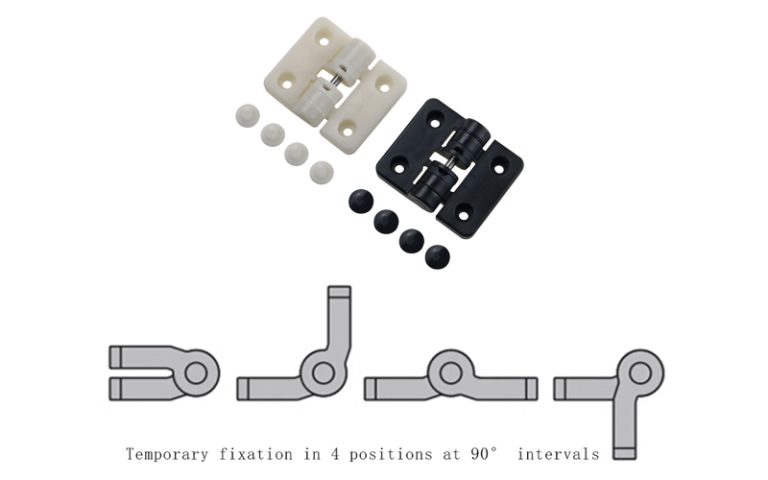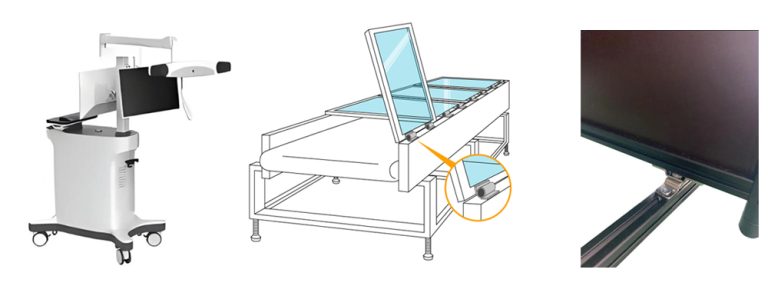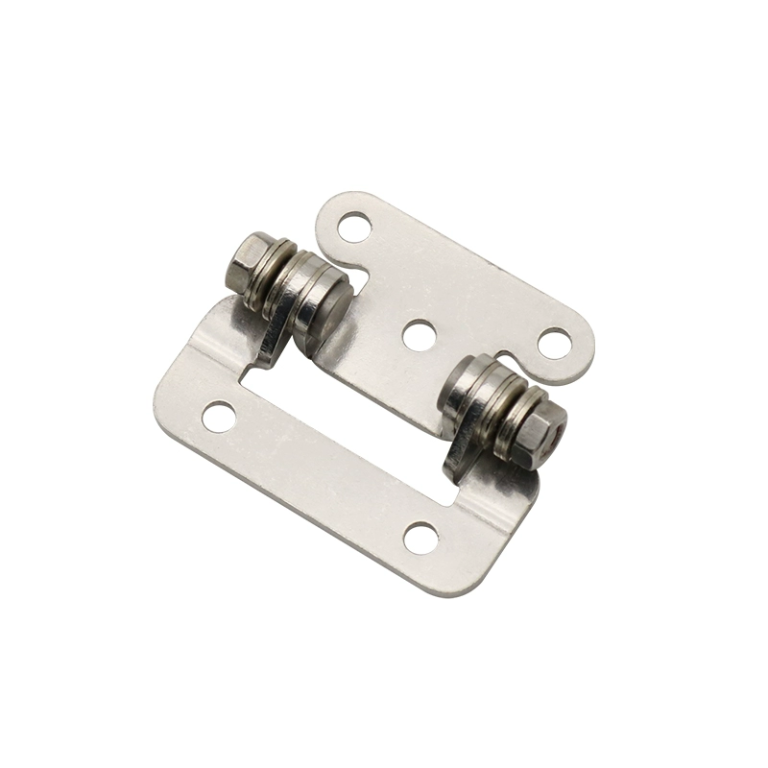HTAN is one of the leading manufacturers of industrial hinges, handles and latches in China.

What is a Torque Hinge?
A Torque Hinge (also known as a resistance hinge) is a rotating device that provides controlled resistance through built-in mechanics such as friction or springs. Its core function is to allow connected components (e.g. screens, hatches) to remain stable while rotating and to hover at any angle. This design is widely used in devices that require frequent adjustments and precise positioning.
Consumer electronics: laptop screens, folding cell phone pivots
Industrial equipment: control cabinet doors, medical instrument holders
Automotive: in-vehicle display adjusters, armrest covers
Core Structure and Components
The performance of a torque hinge depends on the following key components:
1. Swivel shaft (spindle)
- Role: Core component supporting rotary motion
- Material: High strength stainless steel/alloy (wear and corrosion resistant)
- Design: Often with special surface treatments (e.g. plating) to optimize friction control.
2. Friction components
- Function: Generates resistance through friction on contact surfaces.
- Material: Polyoxymethylene (POM), nylon composites (self-lubricating properties)
- Innovative design: Multi-layer stacked structure, resistance is adjusted by increasing or decreasing the number of friction plates.
3. Spring system
- Function: In spring-loaded hinges, a preset resistance is generated by compression or torsion.
- Type selection:
- Coil springs: for medium loads
- Disc springs: for high load scenarios (e.g. industrial equipment)
4. Housing and mounting structure
- Protective design: aluminum housing (lightweight) or steel frame (heavy-duty applications)
- Mounting: Support for recessed (hidden design) or external mounting
5. Adjustment device
- Function: Allows the user to customize the amount of resistance
- Operation mode:
- Screw adjustment (tool required)
- Quick adjustment knob (tool-less design)

Key Features and Benefits
| Features | Technical Description | User Value |
|---|---|---|
| Multi-stage resistance adjustment | Torque range: 0.5N-m~200N-m | Adaptable to different scenarios from cell phone holder to cabinet door. |
| Full-angle hovering | Support 0°-360° stepless positioning or pre-set card position (e.g. 90°/180°) | Adjust the angle of the device with one hand. |
| Long service life | High-quality models can be opened and closed up to 100,000 times (ASTM standard) | to reduce maintenance costs. |
| Environmental Adaptability | Optional waterproof (IP67), high temperature (-40℃~120℃) versions | For outdoor/extreme environments |
| Intelligent Upgrade Options | Integrated angle sensor/motorized adjustment (via APP control) for automation control |
Comparison of Main Types
Classification by Working Principle
| Type | Principle of operation | Typical applications | Advantages | Notes |
|---|---|---|---|---|
| Friction type | Resistance due to friction of contact surfaces | Flat panel stand, monitor arm | Simple structure, low cost | Periodic wear checking required |
| Spring-loaded | Spring compression/twisting produces preload | Automotive lockers, chassis covers | Stable resistance, easily adjustable | Large size |
| Hydraulic | Hydraulic oil damping to control the speed of movement | Aircraft hatch, heavy machinery | High load-bearing capacity, smooth movement | Complex maintenance, high cost |
Classification by Application Scenario
- Consumer electronics: thickness <5mm, silent design (e.g. folding screen cell phone pivot)
- Industrial heavy-duty: torque >50N-m, with anti-vibration structure (e.g. robot joints)
- Medical: FDA-approved, high-temperature sterilizable (operating table adjustment hinges)

Selection Guide: 5 Key Considerations
Load Calculation
- Formula: Required torque ≥ (part weight × distance from center of gravity to axis of rotation) × safety factor (1.5-2)
- Example: 15” laptop screen (1.2kg, center of gravity offset 8cm) requires at least 1.44N-m torque
Installation Space Limitations
- Compact: Thickness <3mm (for ultra-thin devices)
- Customization: Support non-standard hole/shaped structure design
Environmental Requirements
- Chemical environment: select 316 stainless steel (acid and alkali resistant)
- Food medical: FDA 21 CFR compliant
Adjustment Frequency
- High frequency adjustment: choose metal friction plate + self-lubricating design
- Fixed setting: spring type + anti-loosening screws
Certified Standards
- General standards: ISO 9001, RoHS
- Special industry: UL certification (electronic equipment), CE (EU market)
Industry Applications
Consumer Electronics Innovation
- Folding Phone: Samsung Galaxy Z Fold series uses multi-axis torque hinge to support 200,000 folding tests
- VR Headset: Meta Quest Pro uses magnetic torque hinge for fast wear adjustment
Industrial Solutions
- Solar Tracking System: Dual Axis Torque Hinge for ±45° Automatic Angle Adjustment
- Surgical Robot: 7-degree-of-freedom torque joint with 0.1mm positioning accuracy
Smart Home Applications
- Electric lift table: Integrated pressure sensing smart hinge with automatic stop in case of obstruction.
- Invisible door system: damping hinges for silent closure (opening and closing noise <30dB)
Maintenance and Troubleshooting
| Problem Phenomenon | Possible cause | Solution |
|---|---|---|
| Sudden decrease in resistance | Friction plate wear/spring fatigue | Replacement of worn parts (factory maintenance recommended) |
| Insufficient lubrication/contamination | Clean and lubricate with special silicone grease. | |
| Angular positioning failure | Damaged snap mechanism | Check limit devices and replace damaged parts. |
| Localized overheating | Overloaded use/improper lubrication | Immediately stop use and contact a technician |
Future Technology Trends
Smart material applications
- Shape memory alloys: automatic torque adjustment based on temperature
- Magnetorheological fluids: change damping characteristics by means of an electric current (response time <0.1 sec)
Integrated sensing technology
- Real-time monitoring of torque/angle data (supports IoT connectivity)
- Predictive maintenance alerts (early warning via APP)
Sustainable Design
- Removable modular construction (easy to recycle)
- Bio-based composite materials (40% reduction in carbon footprint)
Frequently Asked Questions
Q1: Is it possible to retrofit torque hinges to existing equipment?
A1: The strength of the original structure needs to be assessed, it is recommended to consult a professional engineer. Some models support retrofit kits (with adapter bracket)
Q2: How to check if the torque is up to standard?
A2: Use a torque tester (e.g. Mark-10 series) to measure the rotational starting torque and holding torque.
Q3: Can hinges of different brands be interchanged?
A3: Strict matching of mounting dimensions (hole distance/shaft diameter) and torque curves is required, mixing is not recommended.
Conclusion
As a core component of precision electromechanical systems, torque hinges are driving innovation in consumer electronics, industrial automation and other fields. From ensuring the reliability of 200,000 openings and closings of folded cell phones to realizing millimeter-level precision positioning of surgical robots, its technological innovation continues to break through physical boundaries. Understanding how they work and mastering selection techniques will help you achieve the perfect balance between function and aesthetics in your product design.







